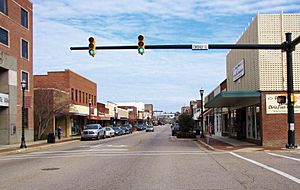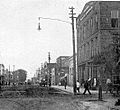Laurinburg, North Carolina facts for kids
Quick facts for kids
Laurinburg, North Carolina
|
||
|---|---|---|

Main Street in Laurinburg
|
||
|
||
| Nickname(s):
LBG, The Burg
|
||

Location in Scotland County and the state of North Carolina.
|
||
| Country | United States | |
| State | North Carolina | |
| County | Scotland | |
| Incorporated | 1877 | |
| Area | ||
| • Total | 12.71 sq mi (32.91 km2) | |
| • Land | 12.55 sq mi (32.50 km2) | |
| • Water | 0.16 sq mi (0.41 km2) | |
| Elevation | 217 ft (66 m) | |
| Population
(2020)
|
||
| • Total | 14,978 | |
| • Density | 1,193.75/sq mi (460.91/km2) | |
| Time zone | UTC−5 (Eastern (EST)) | |
| • Summer (DST) | UTC−4 (EDT) | |
| ZIP codes |
28352-28353
|
|
| Area codes | 910, 472 | |
| FIPS code | 37-37220 | |
| GNIS feature ID | 2404892 | |
Laurinburg is a city in Scotland County, North Carolina, United States. It is the main city (county seat) of Scotland County. Laurinburg is located in the southern part of North Carolina, close to the South Carolina border. It is southwest of Fayetteville and is home to St. Andrews University. In 2020, about 14,978 people lived in Laurinburg.
Contents
History of Laurinburg
People first settled in the area where Laurinburg is now around 1785. The settlement was named after a well-known family called the McLaurins. The name was first spelled "Laurinburgh," but the "h" was later removed.
In 1840, Laurinburg was a small place with just a saloon, a store, and a few simple homes. A private school called Laurinburg High School opened in 1852. The town started to grow after this. A railroad line was built through Laurinburg in the 1850s, and the first train arrived in 1861.
During the American Civil War, the railroad's repair shops were moved to Laurinburg in 1865. This was done to keep them safe from attacks by the Union Army. However, Union forces still reached Laurinburg in March 1865 and burned the railroad station and temporary shops. The shops were later rebuilt. Laurinburg officially became a town in 1877.
In 1894, the railroad shops moved out of town. This, along with low prices for cotton, caused property values to drop. The town went through a difficult time with less money and fewer jobs.
By the late 1800s, the area was mostly made up of African American citizens. They often supported the Republican Party. However, the state of North Carolina was mostly controlled by the Democratic Party. Because of this, white Democrats in Laurinburg worked to gain more political power. In 1899, Laurinburg and the surrounding area were separated from Richmond County to form a new area called Scotland County. Laurinburg was chosen as the main city for Scotland County in 1900, and the first courthouse was built the next year.
As their influence in public matters decreased, local African American citizens created the Laurinburg Normal Industrial Institute in 1904. This school was later known as Laurinburg Academy.
Main Street in Laurinburg was paved in 1914. The Great Depression, a time of severe economic hardship, hit Laurinburg hard starting in 1929. Two banks in the city failed during this time. A new courthouse was built in 1964. Laurinburg's downtown area started to decline economically in the 1980s. This happened when a large department store, Belk, moved to a shopping center further away. In 2018, Hurricane Florence caused a lot of damage to the downtown area.
Historic Places to See
Several places in Laurinburg are listed on the National Register of Historic Places listings in Scotland County, North Carolina. These are important historical sites. They include:
- John Blue House
- Mag Blue House
- Central School
- Dr. Evan Alexander Erwin House
- E. Hervey Evans House
- Thomas J. Gill House
- Laurel Hill Presbyterian Church
- Laurinburg Commercial Historic District
- St. Andrews University
- Stewart-Hawley-Malloy House
- Laurinburg Institute
- Villa Nova
Geography of Laurinburg
The city of Laurinburg covers a total area of about 12.71 square miles (32.91 square kilometers). Most of this area is land, about 12.55 square miles (32.5 square kilometers). A small part, about 0.16 square miles (0.41 square kilometers), is water.
Laurinburg is located about 19 miles (31 km) northeast of Bennettsville. It is also about 26 miles (42 km) east of Rockingham. The city is 32 miles (51 km) west of Lumberton and 41 miles (66 km) southwest of Fayetteville.
Population Information
| Historical population | |||
|---|---|---|---|
| Census | Pop. | %± | |
| 1880 | 968 | — | |
| 1890 | 1,357 | 40.2% | |
| 1900 | 1,334 | −1.7% | |
| 1910 | 2,322 | 74.1% | |
| 1920 | 2,643 | 13.8% | |
| 1930 | 3,312 | 25.3% | |
| 1940 | 5,685 | 71.6% | |
| 1950 | 7,134 | 25.5% | |
| 1960 | 8,242 | 15.5% | |
| 1970 | 8,859 | 7.5% | |
| 1980 | 11,480 | 29.6% | |
| 1990 | 11,643 | 1.4% | |
| 2000 | 15,874 | 36.3% | |
| 2010 | 15,962 | 0.6% | |
| 2020 | 14,978 | −6.2% | |
| U.S. Decennial Census | |||
2020 Census Details
| Race | Num. | Perc. |
|---|---|---|
| White | 5,552 | 37.07% |
| Black or African American | 7,115 | 47.5% |
| Native American | 1,012 | 6.76% |
| Asian | 189 | 1.26% |
| Pacific Islander | 6 | 0.04% |
| Other/Mixed | 688 | 4.59% |
| Hispanic or Latino | 416 | 2.78% |
As of the 2020 United States Census, there were 14,978 people living in Laurinburg. These people made up 5,712 households and 3,544 families. A large part of the African American population lives in the northern section of the city.
Education in Laurinburg
High School
- Scotland High School is the local high school.
College
- The city is home to St. Andrews University. It used to be known as St. Andrews Presbyterian College.
Media
- Laurinburg has its own local newspaper called The Laurinburg Exchange.
- The local radio station is WLNC.
Notable People from Laurinburg
Many interesting people have come from Laurinburg, including:
- Russ Adams, a former professional baseball player for the Toronto Blue Jays.
- Megan Brigman, a former professional women's soccer player.
- Brent Butler, a former professional baseball player.
- Bucky Covington, a country music singer and finalist on American Idol.
- Wes Covington, a former professional baseball player.
- Robert Dozier, a professional basketball player.
- Lorinza Harrington, a former professional basketball player in the NBA.
- Joseph Roswell Hawley, a former U.S. Senator and Governor of Connecticut.
- Harriet McBryde Johnson, an activist who worked for people with disabilities.
- Sam Jones, a legendary basketball player for the Boston Celtics, winning 10 NBA championships.
- Samantha Joye, an oceanographer known for studying the Deepwater Horizon Oil Spill.
- Terrell Manning, a former NFL football player.
- William S. McArthur, a former U.S. Army colonel and NASA astronaut.
- Bejun Mehta, a famous singer (countertenor).
- James Dickson Phillips Jr., a United States Court of Appeals judge.
- William R. Purcell, a doctor and politician.
- Travian Robertson, a former NFL defensive end.
- Kelvin Sampson, a well-known college basketball coach.
- Terry Sanford, a former Governor of North Carolina and U.S. Senator.
- Charlie Scott, an NBA All-Star and Olympic gold medalist in basketball.
- Woody Shaw, a famous jazz trumpeter.
- Franklin Stubbs, a former professional baseball player.
- Hilee Taylor, a former NFL defensive end.
- Leonard Thompson, a professional golfer on the PGA Tour.
- Ben Vereen, a famous actor, dancer, and singer.
- Jacoby Watkins, a former NFL cornerback.
- Zamir White, a professional football running back for the Las Vegas Raiders.
Sister Cities
Laurinburg has one sister city, which means they have a special friendly relationship:
 Oban, Argyll and Bute, Scotland
Oban, Argyll and Bute, Scotland
Images for kids
See also
 In Spanish: Laurinburg para niños
In Spanish: Laurinburg para niños


